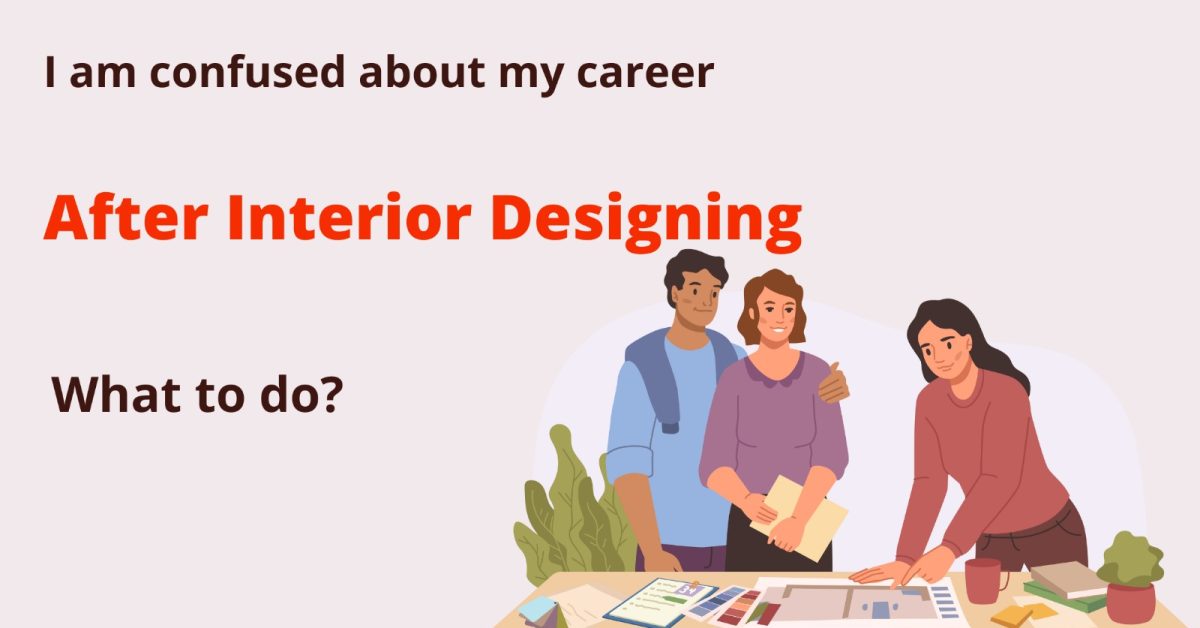Just got done with a great course in Interior design but confused as to what’s next. Don’t fret over it, as you are not alone in this. Many freshers face the same dilemma each year, and we are well-equipped to help them.
All About Interior Designing:
To pursue a career in interior design, the aspirant must have a good understanding of the principles of design and a mix of technical and creative skills.
The main role of an interior designer in a firm is to make any given indoor space safe, beautiful, and functional. This is done by determining space requirements and selecting required and decorative items as well as taking factors like airflow, electrical and plumbing regulations, heat, and extraction into consideration.
The Future Of Interior Design:
The field of interior design is teeming with employment opportunities and the future looks very promising for those aspiring to pursue a career in this field.
According to P&S Intelligence, the interior design market is expected to grow 14.1% between 2020-30. In India, the market for home interiors and renovation is estimated to be between USD 20-30 billion. With the investment real estate market on the rise, the demand for interior designers is also on the rise.
Skills Required:
To succeed in a career in interior design, you’ll need a combination of great communication skills, creative expression, and technical knowledge. Here are some of the skills needed:
- Creativity and Eye for Detail:
Interior designing is an artistic career choice. You’ll be required to be very creative. You need to be able to adapt your creative plans to your client’s needs and tastes. You’ll also need great attention to even the smallest of details and focus on the bigger picture simultaneously.
- Colors Knowledge:
Colors can break or make a space as they have transformative powers. Interior designers must know how to use it to their advantage. A mastery of color theory can help you distinguish yourself from other interior designers in the market.
- Identification of Latest Trends:
You’ll need to be on top of the latest trends to stay relevant and in demand. You’ll need to use jargon like mid-century modern look or French country aesthetic.
- Communication Skills:
As an interior designer, you will need to excel at communicating your vision to your clients and also listen effectively to understand their tastes and needs. You’ll also most probably be working with contractors, architects, and engineers who’ll be responsible for the success of your designs.
- Spatial Sense:
An interior designer ensures a balance between lighting, furniture, and fixtures to set the desired tone for their client’s homes or office spaces. For example, many fast-food joints use designs that ensure that customers don’t stay for long.
- Budgeting:
Most clients will come to the designers with a concept and a budget in mind. In most cases, the cost of executing their idea will surpass their budget. Budgeting skills will aid you to give them a realistic view of what they can get in their budget.
Career Prospects For Interior Designers:
Interior design is one of the most popular career choices amongst the youth of India. Interior designers can find the best job opportunities if they have good communication skills and technical knowledge of the field. According to a report by Brandongaille, the jobs in interior design are expected to grow by 13% in the next decade. Without further ado, let’s explore the various career prospects for interior designers:
- Commercial Designer:
Commercial design is a specialized field of spatial designing that is related to building and optimum utilization of spaces for retail purposes. It focuses on planning and designing functional layouts for retail stores, office spaces, and other commercial spaces.
- Healthcare Designer:
Healthcare designers design and renovate healthcare clinics, centers, doctor offices, and hospitals. They make decisions based on reliable research to optimize their outcomes for both the patients and the facility.
- Residential Designer:
Residential designers combine creative and technical skills to develop plans for residences that improve the looks, efficiency, comfort, and functionality. Residential designers specialize in designing homes, personal spaces, and apartments.
- Lighting Designer:
Lighting designers change the ambiance of any space with an optimal lighting installation that improves the visual appeal and illuminates its architectural features. Their role is to ensure a home is correctly lit, is economical, focuses on design features, and ensures simplicity everywhere else.
- Set Designer:
With the entertainment industry on the rise in India, set designers have a major role to play in designing a captivating scenery in which a stage, television, or film performance takes place. They breathe life into concepts and scripts by creating environments that reflect the narrative and aesthetic required.
- Exhibition Designer:
Exhibition designers create fixtures and display stands for large public exhibitions, and trade shows. They design the floor work and seating arrangements. They also strategize the design elements to showcase products and convey the brand messages effectively.
- Kitchen Designer:
They specialize in creating, remodeling, and designing kitchen aesthetics and preparing kitchen layouts using blueprints and sketches that focus on the color scheme, themes, patterns, and the optimization of storage, space, fixtures, appliances, lighting, and plumbing.
- Interior Decorator:
The primary duty of an interior decorator is choosing various decorative elements for the client’s residential or office spaces. They also recommend wall designs, color schemes, furniture pieces, rugs, and upholstery.
- Color Consultant:
Color consultants ensure that the residential or office space has an appropriate atmosphere that matches the client’s vibe. They take into account all factors like your space, furnishings, taste, lighting, and architectural design to pick out the most suitable color palettes that work best with the client’s space.
- Freelance Interior Designer:
Freelance interior designers help clients create, decorate, and furnish their residential or office spaces. They have the flexibility to pick their projects, set their own schedules, and decide how much fees they charge for their services.
- Landscape Architect:
Landscape architects develop and decorate gardens, yards, parks, grounds, campuses, and any other outdoor spaces. They design and engineer various structures for construction and human use. They investigate existing ecological, social, and soil conditions in the surroundings.
- Visual Merchandiser:
Visual merchandisers define, design, and implement a creative visual merchandising strategy to get buyer’s attention, increase sales, and create an excellent in-store experiment. Their role consists of presenting, displaying, and arranging in stores, in catalogs, or online and promoting retailers’ brands, products, and services.
Conclusion:
Some of the fields in which interior designers can find these jobs are namely, architectural firms, interior design firms, construction companies, set designing companies, the residential sector, the hospitality sector, educational institutions, event management companies, and many more.
Lastly, a career in Interior Design offers a variety of job opportunities to create aesthetically pleasing surroundings while expressing your creativity and individuality. Whether you’re just starting or looking to advance your career, with the right mindset, dedication, and skills, you can have great success in this field.




